1998 CADILLAC SEVILLE fuse
[x] Cancel search: fusePage 10 of 378
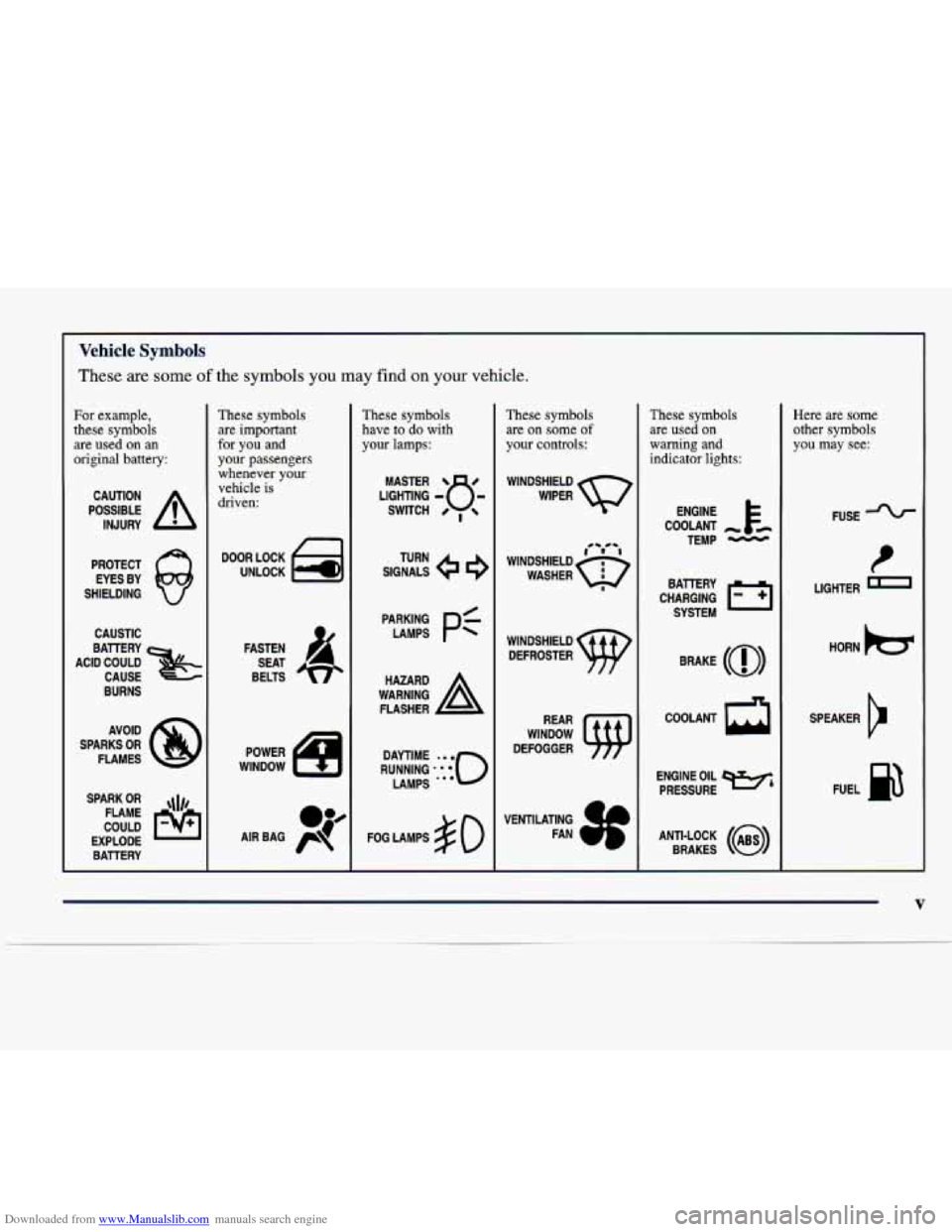
Downloaded from www.Manualslib.com manuals search engine L
Vehicle Symbols
These are some of the symbols you may find on your vehicle.
For example,
these symbols are
used on an
original battery:
POSSIBLE A
CAUTION
INJURY
PROTECT EYES BY
SHIELDING
CAUSTIC
BURNS
SPARK
OR ,\I/,
COULD FLAME
EXPLODE BAlTERY
These symbols are important
for you and
your passengers whenever your
vehicle is
driven:
DOOR LOCK
UNLOCK
FASTEN SEAT
BELTS
These symbols have to
do with
your lamps:
SIGNALS e e
TURN
FOG LAMPS
# 0
These symbols
are on
some of
your controls:
WINDSHIELD
WIPER
WINDOW
DEFOGGER
These symbols are used on
warning and
indicator lights:
COOLANT -
TEMP -
CHARGING BAllERY
SYSTEM
BRAKE
(0)
COOLANT a
ENGINE OIL e,
PRESSURE
ANTI-LOCK
(a)
BRAKES
Here are some
other symbols
you may see:
FUSE
P
LIGHTER I
HORN be
SPEAKER
12
FUEL B
V
Page 76 of 378
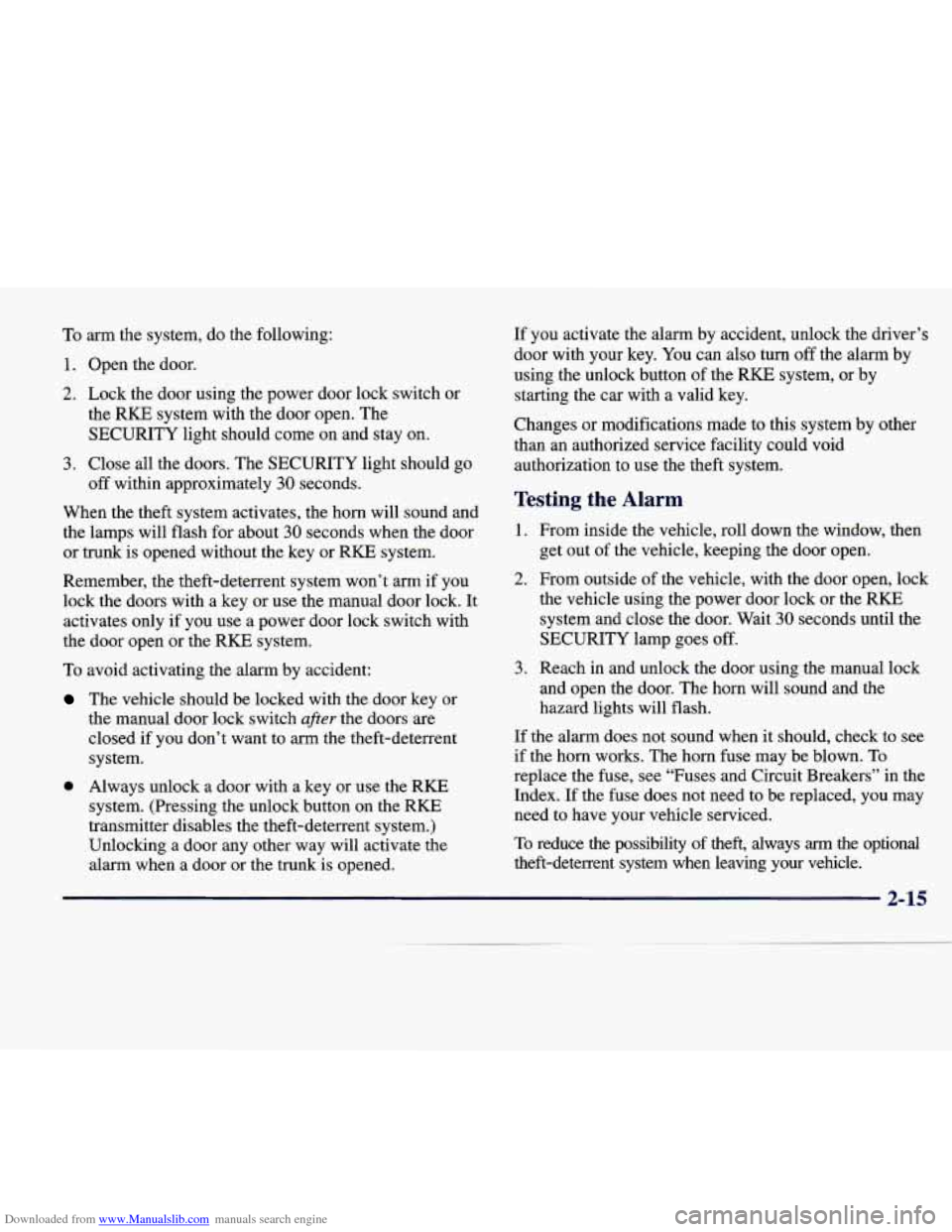
Downloaded from www.Manualslib.com manuals search engine To arm the system, do the following:
1. Open the door.
2. Lock the door using the power door lock switch or
the RKE system with the door open. The
SECURITY light should come on and stay on.
off within approximately
30 seconds.
3. Close all the doors. The SECURITY light should go
When the theft system activates, the horn will sound and
the lamps will flash for about
30 seconds when the door
or trunk is opened without the key or RISE system.
Remember, the theft-deterrent system won’t arm if you
lock the doors with a key or use the manual door lock. It
activates only if you use a power door lock switch with
the door open or the
RKE system.
To avoid activating the alarm by accident:
The vehicle should be locked with the door key or
the manual door lock switch
after the doors are
closed
if you don’t want to arm the theft-deterrent
system.
0 Always unlock a door with a key or use the RKE
system. (Pressing the unlock button on the RKE
transmitter disables the theft-deterrent system.)
Unlocking a door any other way will activate the
alarm when a door or the trunk is opened. If you
activate the alarm by accident, unlock the driver’s
door with your key. You can also turn off the alarm by
using the unlock button
of the RKE system, or by
starting the car with
a valid key.
Changes or modifications made to this system by other than an authorized service facility could void
authorization to use the theft system.
Testing the Alarm
1. From inside the vehicle, roll down the window, then
get out of the vehicle, keeping the door open.
2. From outside of the vehicle, with the door open, lock
the vehicle using the power door lock or the RKE
system and close the door. Wait
30 seconds until the
SECURITY lamp goes
off.
3. Reach in and unlock the door using the manual lock
and open the door. The horn will sound and the
hazard lights will flash.
If the alarm does not sound when it should, check to see
if the horn works. The horn fuse may be blown. To
replace the fuse, see “Fuses and Circuit Breakers” in the
Index. If the fuse does not need to be replaced, you may
need to have your vehicle serviced.
To reduce the possibility of theft, always
arm the optional
theft-deterrent system when leaving your vehicle.
Page 78 of 378
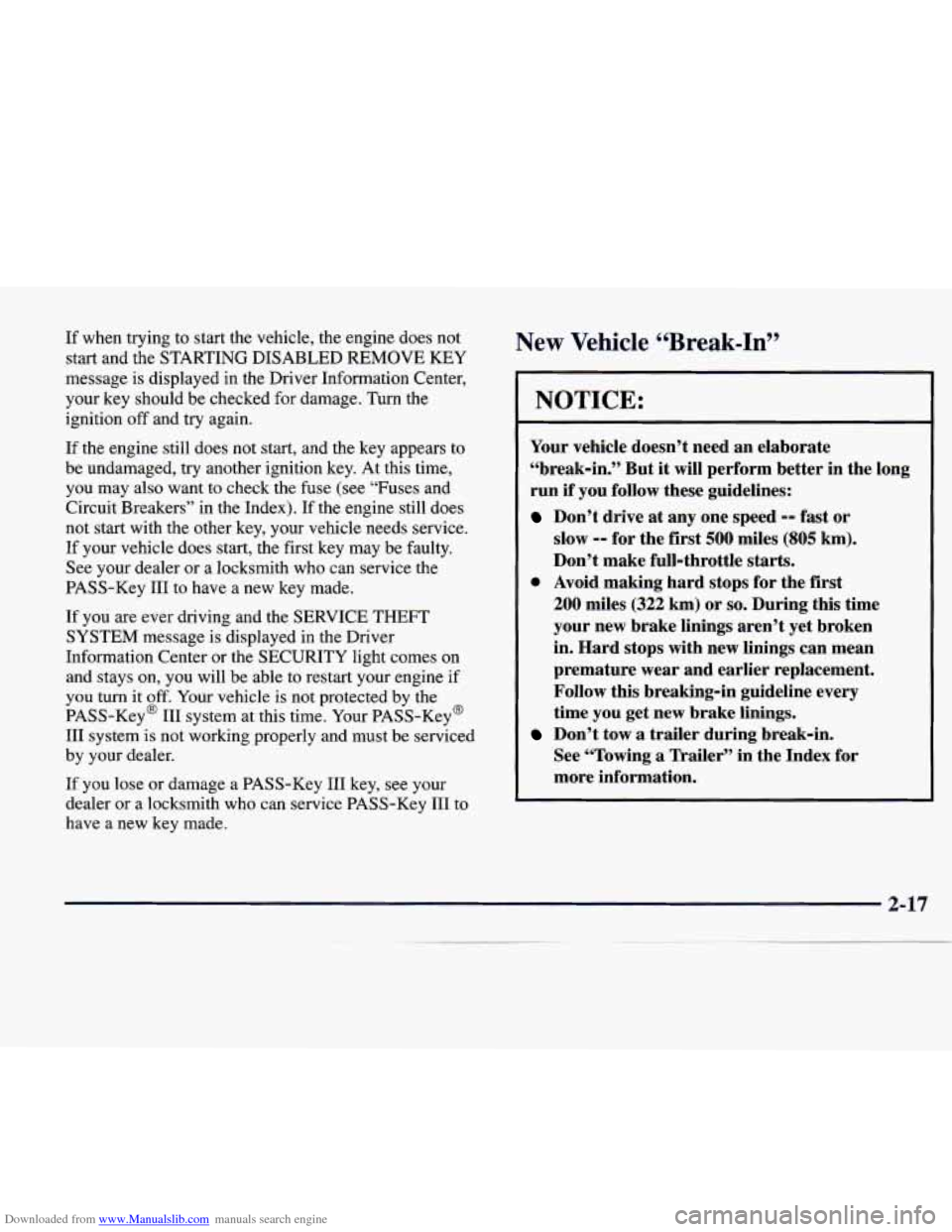
Downloaded from www.Manualslib.com manuals search engine If when trying to start the vehicle, the engine does not
start and the STARTING DISABLED REMOVE KEY
message is displayed in the Driver Information Center,
your key should be checked for damage.
Turn the
ignition
off and try again.
If the engine still does not start, and the key appears to
be undamaged, try another ignition key. At this time, you may also want to check the fuse (see “Fuses and
Circuit Breakers’’ in the Index). If the engine still does
not start with the other key, your vehicle needs service.
If your vehicle does start, the first key may be faulty.
See your dealer or a locksmith who can service the
PASS-Key
I11 to have a new key made.
If you are ever driving and the SERVICE
THEFT
SYSTEM message is displayed in the Driver
Information Center or the
SECURITY light comes on
and stays on, you will be able to restart your engine if
you
turn it off. Your vehicle is not protected by the
PASS-Key@
111 system at this time. Your PASS-Key@
I11 system is not working properly and must be serviced
by your dealer.
If you lose or damage a PASS-Key I11 key, see your
dealer or a locksmith who can service PASS-Key
111 to
have a new key made.
New Vehicle 66Break-In”
NOTICE:
Your vehicle doesn’t need an elaborate
“break-in.” But it will perform better in the long
run
if you follow these guidelines:
Don’t drive at any one speed -- fast or
slow
-- for the first 500 miles (805 km).
Don’t make full-throttle starts.
200 miles (322 km) or so. During this time
your new brake linings aren’t yet broken
in. Hard stops with new linings can mean
premature wear and earlier replacement.
Follow this breaking-in guideline every
time you get new brake linings.
See “Towing a Trailer” in the Index
for
more information.
0 Avoid making hard stops for the first
Don’t tow a trailer during break-in.
Page 94 of 378
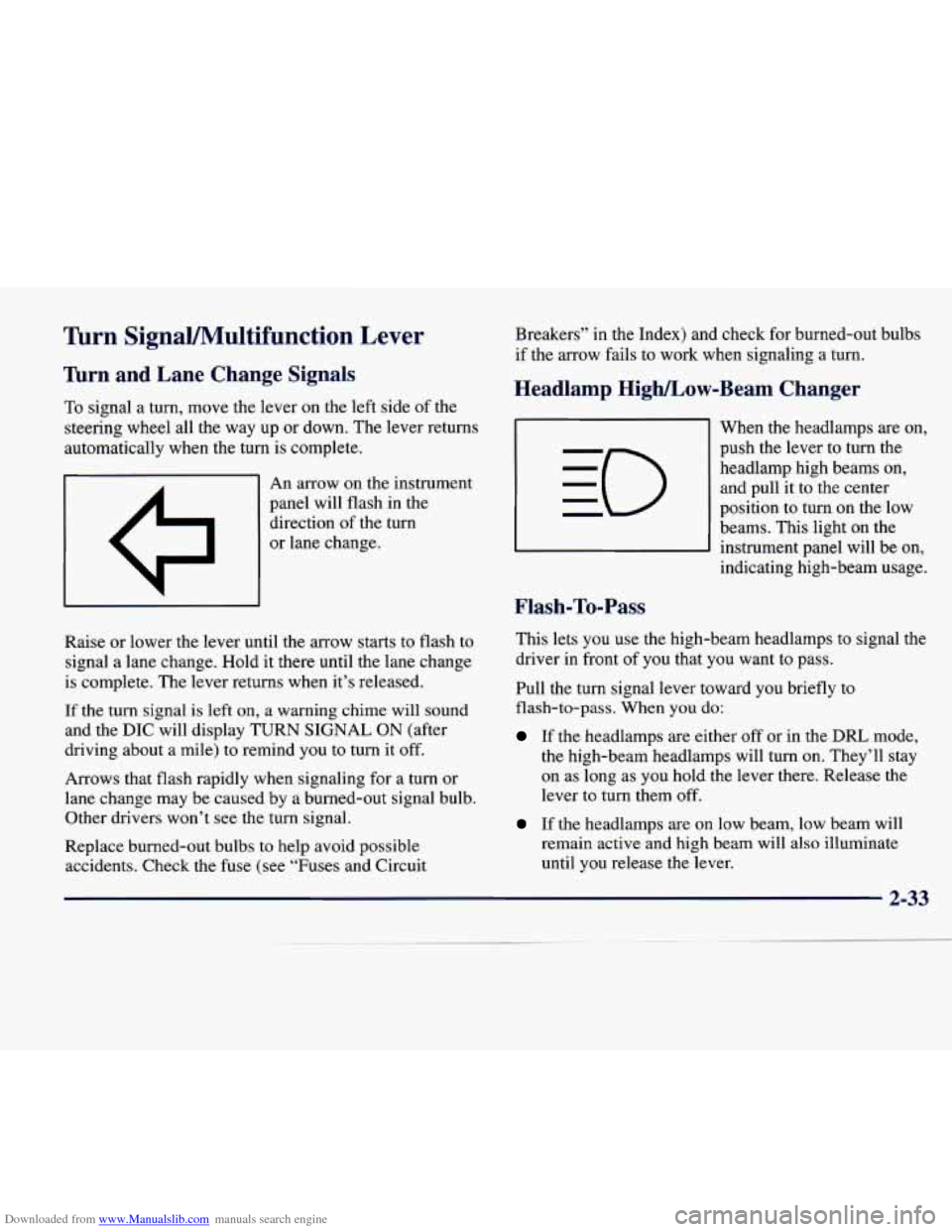
Downloaded from www.Manualslib.com manuals search engine Turn SignaVMultifunction Lever
’hrn and Lane Change Signals
To signal a turn, move the lever on the left side of the
steering wheel all the
way up or down. The lever returns
automatically when the turn is complete.
I A I An arrow on the instrument
panel will flash in the
direction of the turn
or lane change.
Raise or lower the lever until the arrow starts to flash to
signal a lane change. Hold it there until the lane change
is complete. The lever returns when it’s released.
If the turn signal is left
on, a warning chime will sound
and the
DIC will display TURN SIGNAL ON (after
driving about a mile) to remind you to turn it off.
Arrows that flash rapidly when signaling for
a turn or
lane change may be caused by a burned-out signal bulb. Other drivers won’t see the turn signal.
Replace burned-out bulbs
to help avoid possible
accidents. Check the fuse (see “Fuses and Circuit Breakers”
in the Index) and check
for burned-out bulbs
if the arrow fails to work when signaling
a turn.
Headlamp High/Low-Beam Changer
Flash-To-Pass
When the headlamps are on,
push the lever to turn the headlamp high beams on, and pull it to the center
position
to turn on the low
beams. This light on the
instrument panel will be on,
indicating high-beam usage.
This lets
you use the high-beam headlamps to signal the
driver in front
of you that you want to pass.
Pull the turn signal lever toward you briefly to
flash-to-pass. When
you do:
If the headlamps are either off or in the DRL mode,
the high-beam headlamps will turn
on. They’ll stay
on as long as you hold the lever there. Release the
lever to turn them off.
If the headlamps are on low beam, low beam will
remain active and high beam will also illuminate
until you release the lever.
Page 278 of 378
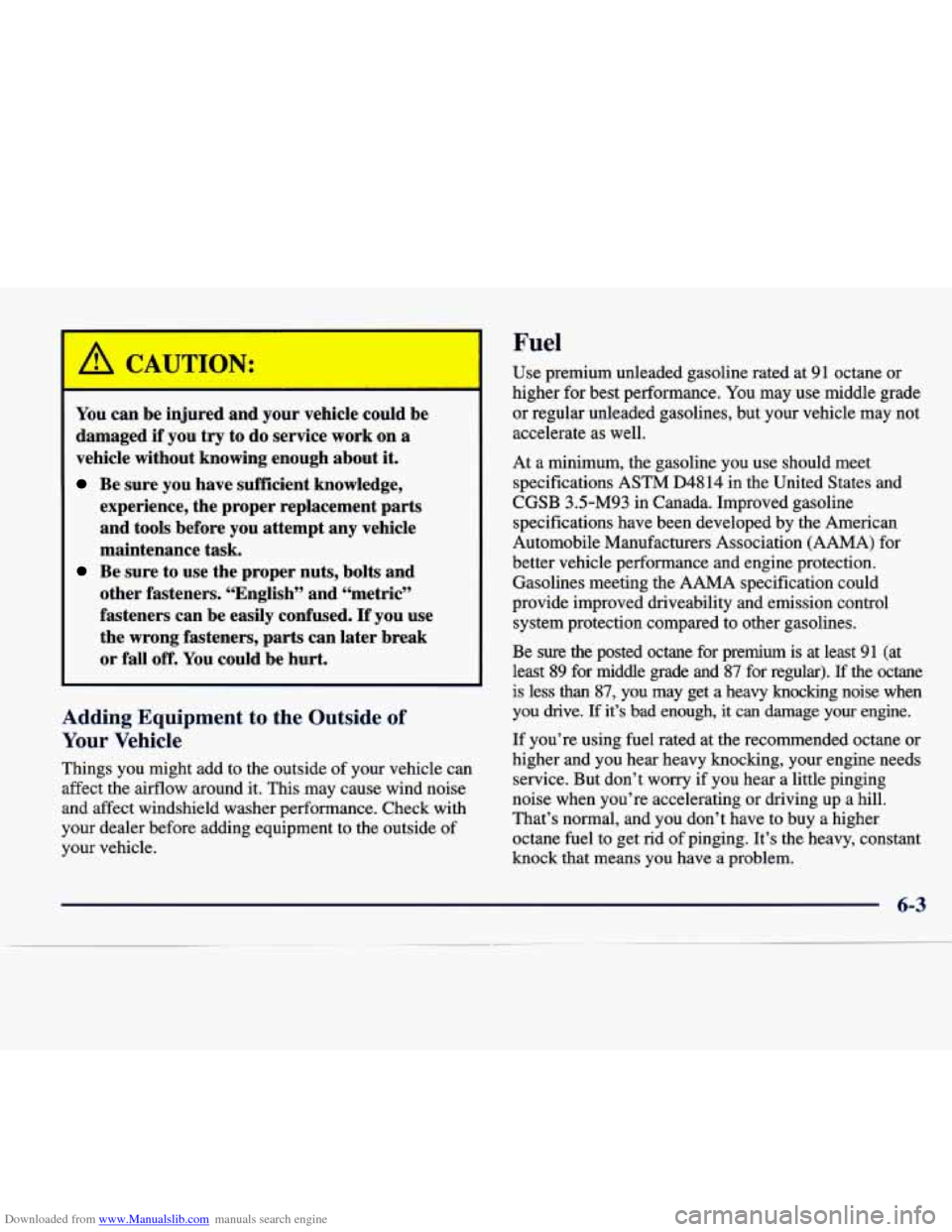
Downloaded from www.Manualslib.com manuals search engine Fuel
You can be injured and your vehicle could be
damaged if you
try to do service work on a
vehicle without knowing enough about it.
Be sure you have sufficient knowledge,
experience, the proper replacement parts
and tools before you attempt any vehicle
maintenance task.
Be sure to use the proper nuts, bolts and
other fasteners. “English” and “metric”
fasteners can be easily confused. If you use
the wrong fasteners, parts can later break
or fall off. You could be hurt.
Adding Equipment to the Outside of
Your Vehicle
Things you might add to the outside of your vehicle can
affect the airflow around it. This may cause wind noise
and affect windshield washer performance. Check with
your dealer before adding equipment to the outside of
your vehicle. Use premium unleaded gasoline rated at
91 octane or
higher for best performance. You may
use middle grade
or regular unleaded gasolines, but your vehicle may not
accelerate as well.
At
a minimum, the gasoline you use should meet
specifications
ASTM D4814 in the United States and
CGSB 3.5-M93 in Canada. Improved gasoline
specifications have been developed by the American
Automobile Manufacturers Association
(AAMA) for
better vehicle performance and engine protection.
Gasolines meeting the AAMA specification could
provide improved driveability and emission control
system protection compared
to other gasolines.
Be sure the posted octane for premium is at least 91 (at
least
89 for middle grade and 87 for regular). If the octane
is less than 87, you may get a heavy knocking noise when
you
drive. If it’s bad enough, it can darnage your engine.
If you’re using fuel rated at the recommended octane or
higher and you hear heavy knocking, your engine needs service. But don’t worry if you hear a little pinging
noise when you’re accelerating or driving up a hill.
That’s normal, and you don’t have to buy a higher octane fuel
to get rid of pinging. It’s the heavy, constant
knock that means you have a problem.
Page 301 of 378
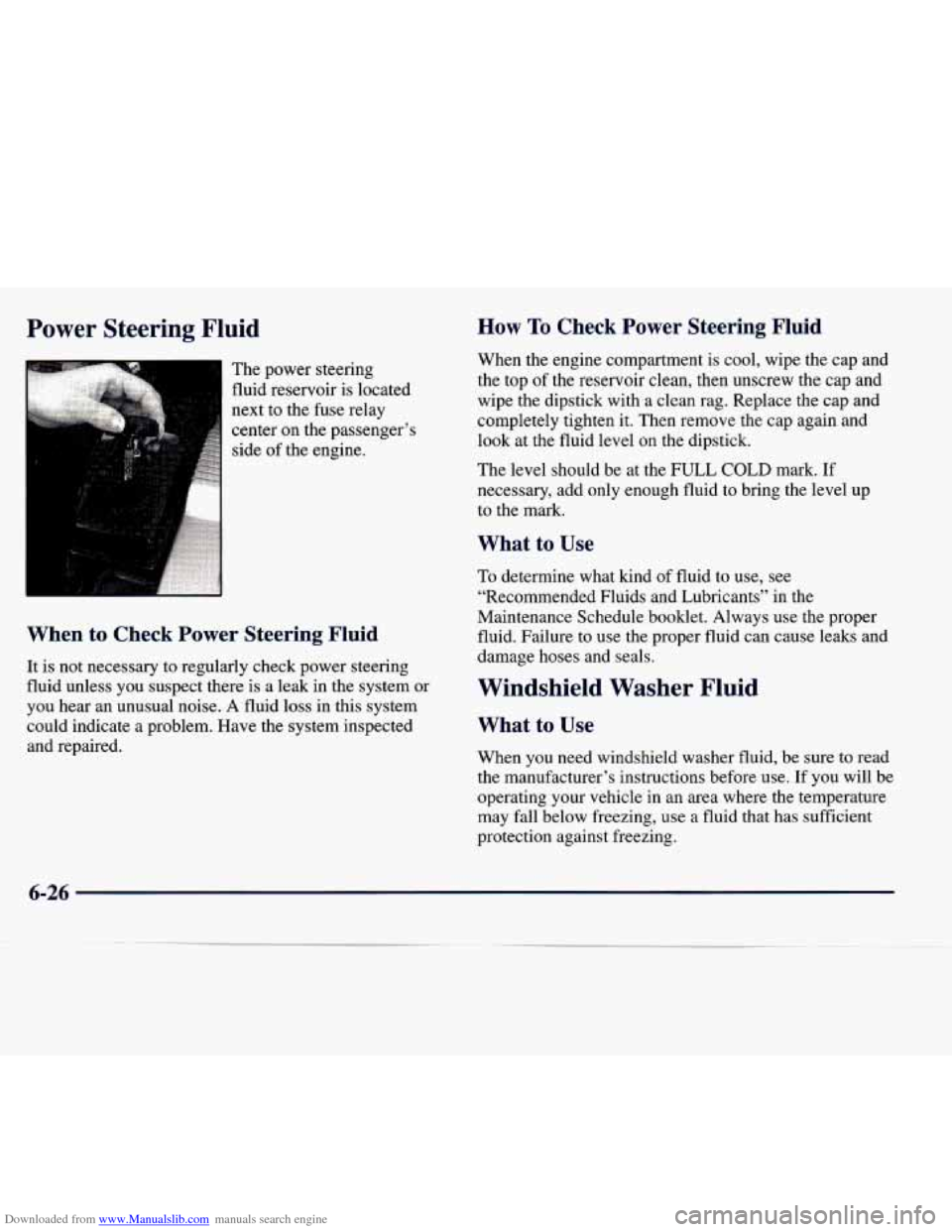
Downloaded from www.Manualslib.com manuals search engine Power Steering Fluid
The power steering
fluid reservoir is located
next to the fuse relay
center on the passenger’s
side of the engine.
When to Check Power Steering Fluid
It is not necessary to regularly check power steering
fluid unless you suspect there
is a leak in the system or
you hear an unusual noise. A fluid loss in this system
could indicate a problem. Have the system inspected
and repaired.
How To Check Power Steering Fluid
When the engine compartment is cool, wipe the cap and
the top of the reservoir clean, then unscrew the cap and
wipe the dipstick with a clean rag. Replace the cap and
completely tighten it. Then remove the cap again and
look at the fluid level on the dipstick.
The level should be at the
FULL COLD mark. If
necessary, add only enough fluid
to bring the level up
to the mark.
What to Use
To determine what kind of fluid to use, see
“Recommended Fluids and Lubricants” in the
Maintenance Schedule booklet. Always use the proper
fluid, Failure
to use the proper fluid can cause leaks and
damage hoses and seals.
Windshield Washer Fluid
What to Use
When you need windshield washer fluid, be sure to read
the manufacturer’s instructions before use.
If you will be
operating your vehicle
in an area where the temperature
may fall below freezing, use a fluid that has sufficient
protection against freezing.
6-26
Page 302 of 378
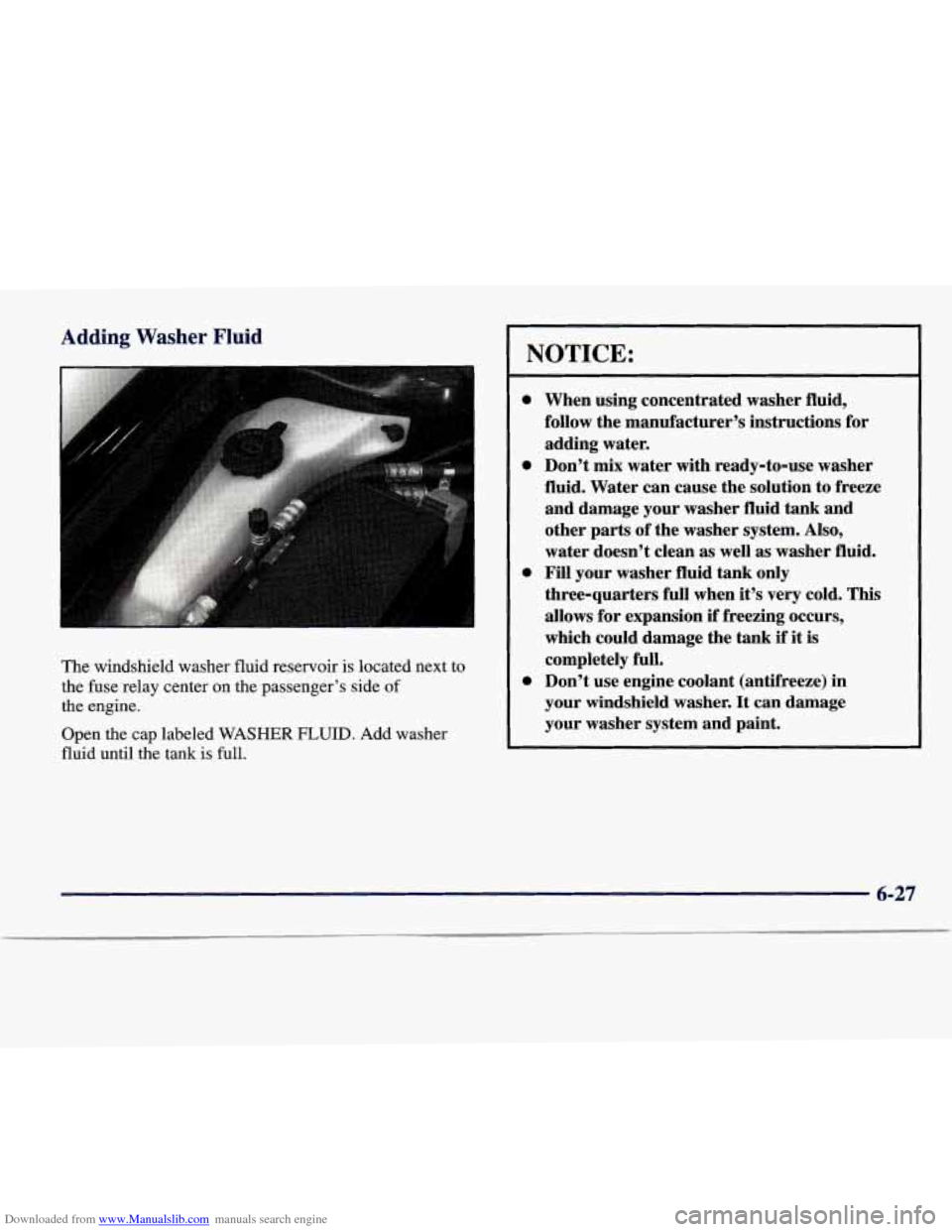
Downloaded from www.Manualslib.com manuals search engine Adding Washer Fluid
The windshield washer fluid reservoir is located next to
the fuse relay center on the passenger’s side of
the engine.
Open the cap labeled WASHER
FLUID. Add washer
fluid until the tank is
full.
NOTICE:
0
0
0
0
When using concentrated washer fluid,
follow the manufacturer’s instructions for
adding water.
Don’t
mix water with ready-to-use washer
fluid. Water can cause the solution to freeze
and damage your washer fluid tank and
other parts of the washer system. Also,
water doesn’t clean
as well as washer fluid.
Fill your washer fluid tank only
three-quarters full when
it’s very cold. This
allows for expansion
if freezing occurs,
which could damage the tank
if it is
completely full.
Don’t use engine coolant (antifreeze) m
your windshield washer.
It can damage
your washer system and paint.
6-27
Page 334 of 378
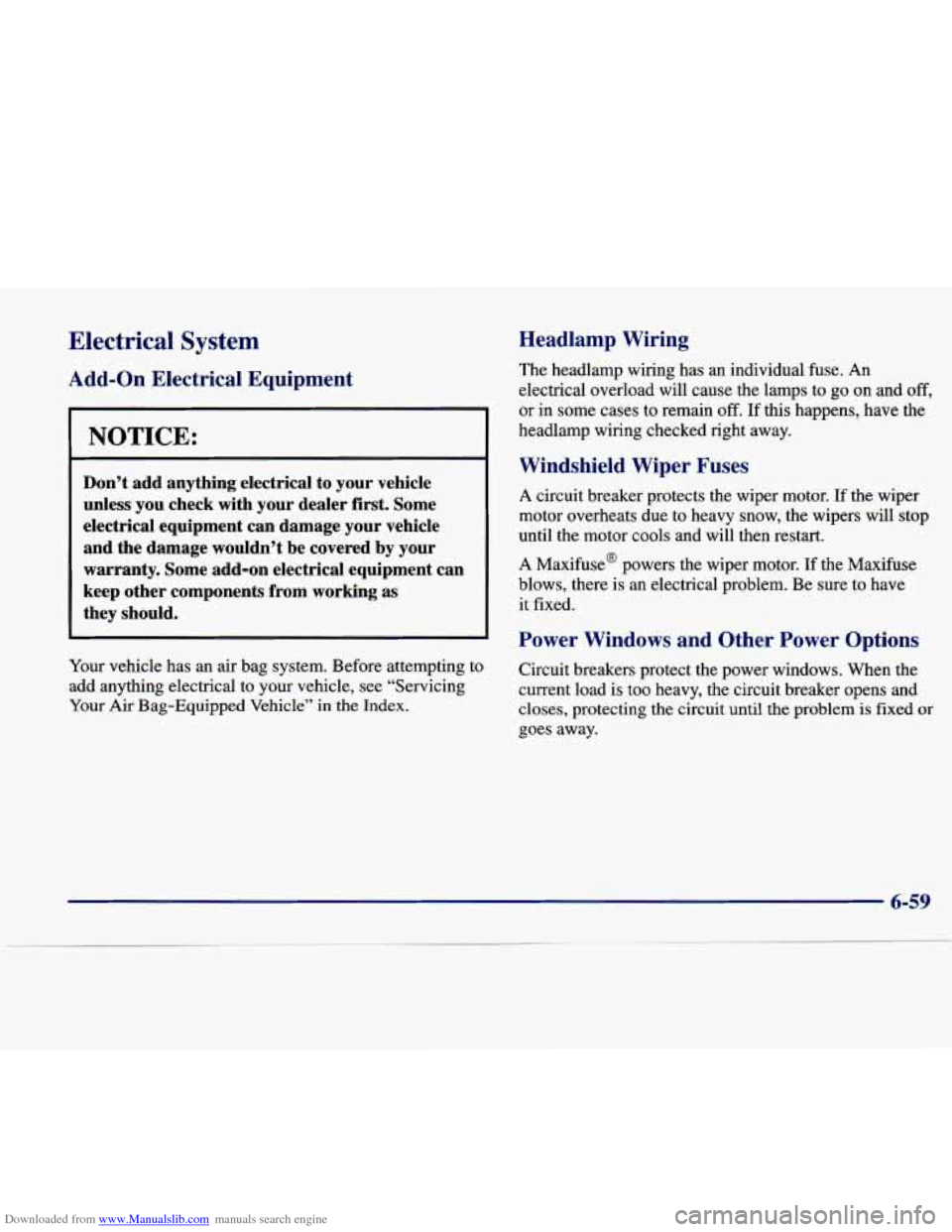
Downloaded from www.Manualslib.com manuals search engine Electrical System
Add-on a1 Equipment
NOTICE:
Don’t add anything electrical to your vehicle unless you check with your dealer first. Some
electrical equipment can damage your vehicle
and the damage wouldn’t be covered by your
warranty. Some add-on electrical equipment can
keep other components
from working as
they
should.
Your vehicle has an air bag system. Before attempting to
add anything electrical to your vehicle, see “Servicing
Your
Air Bag-Equipped Vehicle” in the Index.
Headlamp Wiring
The headlamp wiring has an individual fuse. An
electrical overload will cause the lamps to go on and off,
or in some cases to remain off. If this happens, have the
headlamp wiring checked right away.
Windshield Wiper Fuses
A circuit breaker protects the wiper motor. If the wiper
motor overheats due to heavy snow, the wipers will stop
until the motor cools and will then restart.
A Maxifuse@ powers the wiper motor. If the Maxifuse
blows, there is an electrical problem. Be sure to have
it fixed.
Power Windows and Other Power Options
Circuit breakers protect the power windows. When the
current load is
too heavy, the circuit breaker opens and
closes, protecting
the circuit until the problem is fixed or
goes away.
6-59